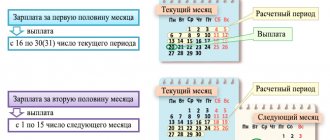When calculating compensation for unused vacation, it is often difficult to determine the calculation period for dismissal on the last day of the month. There is similar uncertainty when calculating average earnings for 3 months for the employment service. Whether or not to include the last month in the calculation depends on the specific date the employee leaves. In this consultation, we discuss dismissal on the last day of the month and calculation of compensation.
How does the day of dismissal affect average earnings with vacation compensation?
One of the payments that an employee receives in the event of dismissal is compensation for unused vacation days. It is calculated using the formula:
Average daily earnings × Number of days of unused vacation |
The average daily earnings are calculated for the 12 months preceding the month of dismissal (Article 139 of the Labor Code of the Russian Federation, Decree of the Government of the Russian Federation dated December 24, 2007 No. 922). To do this, use the formula:
Payroll for 12 months / 12 / 29.3 |
A full calendar month is considered to be the time period from the 1st to the 30th (31st) day of each month (except for February, which lasts until the 28th or 29th).
Based on this, if an employee quit on the last day of the month, then earnings and calendar days for him should be included in the 12-month period to calculate average earnings (Rostrud letter No. 2184-6-1 dated July 22, 2010).
Thus, the calculation for dismissal on the last day of the month is carried out taking into account all its days and earnings for it.
Example
The employee has been working for the company since May 10, 2019. He decided to resign of his own free will on 08/31/2020. During all this time, he was on vacation 1 time for 14 days from November 10, 2019. His monthly salary is 26,000 rubles. Calculate the required vacation compensation.
1. The accounting period for calculation is from 09/01/2019 to 08/31/2020.
2. The number of days of entitlement leave - from 05/10/2020 to 08/31/2020 - will be:
16 months × 2.33 = 37.28 days.
3. Remaining unused vacation:
37.28 – 14 = 13.28 days.
4. Average daily earnings:
(11 × 26,000 + 26,000 × 16/30) / (11 × 29.3 + 16/30 × 29.3) = 29,9867 / 337.93 = 887.36 rubles.
5. The amount of compensation for vacation will be:
887.36 × 13.28 = 11,784.14 rubles.
If an employee quits in the middle of the month, he is not taken into account in the calculation period to determine average earnings. In this case, the billing period is moved back 1 month . So, if an employee quits on August 28, 2020, the calculation period will be 12 months - from August 2021 to July 2021 inclusive.
If an employee resigns, what payments are he entitled to?
On the last working day, management is obliged to make a full settlement with the employee. As a rule, the day of dismissal and the last working day coincide. If these dates do not coincide, then payments are made at the employee’s written request on the next day after receipt of the application.
The employer must pay the employee:
- compensation for unused vacation;
- severance pay (provided for by a collective or labor agreement);
- wages for hours worked (actually), including the final working day.
If the dismissal is voluntary, the employee is not entitled to severance pay.
However, in some cases, this payment is accrued after agreement with the management of the enterprise. Additional payments in case of dismissal are accrued if a legal entity is liquidated, personnel is reduced, or dismissal is required for medical reasons.
The amount of severance pay depends on the reason for dismissal. Depending on the situation, the payment can range from two weeks to a month’s salary of the employee. The key point in the event of dismissal is the correct calculation of the amounts due.
In addition to the Labor Code of the Russian Federation, the regulatory framework in this case is formed by the letter of the Russian Labor Ministry dated December 18, 2012 No. 1519-6-1, the Decree of the Government of the Russian Federation “On the features of the order...” dated December 24, 2007 No. 922.
How to calculate the average salary when leaving at the end of the month
An employee who wants to join the labor exchange as an unemployed person is provided with a certificate of average earnings for 3 months . The form for issuing such information is not fixed . But in practice, they use the form approved by letter of the Ministry of Labor of Russia dated January 10, 2019 No. 16-5/B-5.
To determine average earnings, use the formula:
Payment for work performed for 3 months / Actual number of working days × (Number of working days according to schedule for 3 months / 3) |
If an employee quits on the 31st day of the month (30th day of the month), earnings and working days of this month can be included in the calculation (determination of the RF Armed Forces dated 06/08/2006 No. KAS06-151).
Example
The employee was fired on August 31, 2020, and 3 months before that he had worked in full. In June – 20 working days, in July and August – 21 working days. The monthly salary was 26,000 rubles. Calculate the average salary for the employment service.
Solution:
(26,000 × 3) / 62 days × 62 / 3 = 1258.06 × 20.67 = 26,004.10 rubles.
Read also
11.06.2020
Average wages
Along with determining the period that is used to calculate the amount for unpaid vacation, the method of calculating the average salary of an employee, as another component in calculating the final amount of compensation, is of no small importance . The Labor Code of the Russian Federation regulates the basic requirements for calculating average payment (Article 139):
- Use in calculations of information about the amounts earned for one year that preceded the month the calculations were performed.
- Use during calculations of all payments that made up the organization’s remuneration system and received by the employee.
The average salary is calculated using the formula: UZ =D/12/29.3. In which UDS is the average salary, D is the employee’s income for one year before calculation, 12 is the number of months in a year, 29.3 is working days in one month.
Taking into account Resolution No. 922, if in the period that was taken for calculation, the employee did not work all the required days, then the determination is made using the formula UZ = D / (29.3 * Mn + Mn), where:
- UZ - average salary;
- D - amount of payments for the past year;
- 29.3 - working days in a month;
- Mn - the number of days worked in partial months;
- MP - the number of days that are fully worked by the employee.
So, knowing the size of the employee’s average salary, you can calculate the amount of compensation for unused vacation by multiplying this figure by the number of vacation days due to the employee.
Special situations for calculating payments
Difficulties in determining the amount of vacation compensation may arise in the following cases.
- In the period in which vacation must take place, there are periods of time that are not included in the duration of the working period. The year that follows this period is shifted by the corresponding number of calendar days. Vacations at your own expense are carried forward to the next year only if their total duration exceeds 14 calendar days. Then the shift occurs by the difference between the actual number of days of vacation without pay per year and 14 calendar days.
- The employee quits before the end of the year, for which he has already taken vacation pay. In this case, upon dismissal, he must be withheld vacation pay corresponding to the overpaid part of the vacation. But if the dismissal occurs on grounds that provide the right to payment of these vacation pay in full, then they will not be considered superfluous.
If an employee goes on vacation with subsequent dismissal, then compensation payments must be made on the last working day. On this day, the employee must receive the entire settlement amount, work book and other documents. If the employer delays payments, the employee can contact law enforcement authorities.
Calculation example:
- Linguist Rybkina I.V. has been working in the organization since February 13, 2017, and on April 20, 2021 she quits.
- She is entitled to compensation for unused vacation. The duration of the calculation period for this compensation is from February 13 to March 31, 2021 inclusive.
- Rybkina was on a business trip from February 13 to 28, and on study leave from March 1 to 31. All this time is excluded from the billing period.
- Until February 13, 2021, Rybkina did not work in the organization. Therefore, there is no period preceding the settlement period. Then, to calculate compensation for unused vacation, the chief accountant took into account the period from April 1 to April 20, 2021.
Last day of the month
If the application for resignation is dated on the last day of the month, then when calculating the average salary of the resigning employee, the question often arises of including in the calculated compensation the month in which the employment contract is terminated.
The Labor Code does not precisely regulate this situation, defining only that dates from the 1st to the 30th or 31st are considered a calendar month. Rostrud explains this situation in letter No. 2184−6−1, taking into account whether the last day is a weekend or a working day.
If the deadline is a working day (for example, May 31, 2021), then it must be included in the calculation of the employee’s average salary. This is due to the fact that the day the employment agreement ends is considered the employee’s last working day - and, accordingly, the month has been fully worked and there is no reason not to include it in the calculations.
Another situation occurs if an employee is dismissed on the last non-working day of the month. For example, in 2021 this day may be March 29th. As Rostrud explains, despite the fact that the dismissal occurs on the last day, and the month itself ends later (in the described example - March 31, that is, 2 days later), it turns out that the month has not been fully worked out and therefore it can not be counted during calculating the average salary of an employee for the past year.
Features of calculating compensation for due leave
In some non-standard situations, calculating dismissal compensation for vacation days in general and determining the calculation period in particular can cause difficulties. Let's take a closer look at some of these cases.
- Those working on the basis of civil law contracts do not have the right to vacation compensation upon dismissal, since labor legislation does not apply in this case. However, some payments may be provided for by the local documentation of the enterprise.
- If a short-term employment contract lasting no more than 2 months is concluded with a specialist, then the period for payment of vacation pay is determined according to the rules of Art. 291 of the Labor Code of the Russian Federation, according to which an employee is entitled to 2 vacation days for a month’s work. However, if an open-ended employment contract is terminated earlier than 2 months, then this rule is not applicable.
- During their working career, seasonal specialists earn 2 vacation days monthly (Article 295 of the Labor Code of the Russian Federation). Based on this norm, the dismissal compensation for vacation for such an employee should be calculated.
- Dismissal leave compensation is paid to the employee regardless of the grounds on which he will be dismissed, including when the employment relationship is canceled during the probationary period or in connection with the employee’s misconduct. This follows from the letter of Rostrud dated 07/02/2009 No. 1917-6-1. If in this case the employee has not worked for the company for even six months, the compensation is calculated in proportion to the time worked. If an employee worked in an organization for less than half a month, the vacation period upon dismissal is not compensated (letter of Rostrud dated 06/08/2007 No. 1920-6).
Additional rest
Taking into account current legislation, some workers have the right to additional days of rest earned for some features of the profession. Additional days may be added:
- for the special specifics of work activity;
- hazardous production;
- work in the North;
- irregular working hours.
As the Labor Code of the Russian Federation states, upon completion of the employment agreement, the employee is provided with compensation for all vacation days not taken off. This means that additional leave not taken must also be compensated. In this case, there is no need to separately calculate the amount of payment specifically for additional leave.
Severance pay by days or by hours?
Severance pay reimburses the employee for earnings that he will not be able to receive for a certain period after forced dismissal.
The calculation of paid time depends on the procedure for recording the working time of the dismissed employee.
Daily recording of working hours. If the employee’s working time was measured in days, then severance pay will be paid to him for the number of working days falling within the period for which severance pay is paid.
Example 2. I.V. Galkin worked on a five-day workweek schedule with daily working hours. He was fired due to staff reduction on September 30, 2013.
It is necessary to determine the actual number of working days in the period for which severance pay is paid.
Solution. Upon dismissal due to staff reduction, severance pay is paid for the month from October 1 to October 31, 2013. This period contains 23 working days according to the production calendar of a five-day working week.
If the employee worked on an individual schedule, then the working days are determined based on this schedule.
Example 3. An employee was fired due to staff reduction on July 31, 2013. He was given a part-time working schedule - Monday, Wednesday, Friday. Working hours are recorded in days.
Let's determine the number of working days in the period subject to payment.
Solution. If the employee continued to work, then the working week established for him would be 3 working days.
The period for which severance pay is paid from August 1 to August 31, 2013 is 13 working days.
Summarized working time recording. If the employee has been established with a summarized recording of working hours, severance pay is paid for the number of working hours that the employee does not work due to dismissal.
When an employee is dismissed, a work schedule for him is no longer drawn up. In such a situation, determining the number of working hours in the first month after the employee’s dismissal is difficult. The number of working hours should be determined based on the established schedule for this category of workers:
— 40-hour work week;
— 36-hour work week;
— 24-hour work week.
Example 4. An employee was fired due to staff reduction on August 26, 2013. He was given a cumulative accounting of working hours based on a 40-hour work week.
It is necessary to determine the number of working hours in the period subject to payment.
Solution. In this case, the number of working hours for calculating severance pay is determined according to the working time according to the production calendar for a 40-hour working week in the period from August 27 to September 26, 2013. It amounts to 184 slaves. h (23 working days x 8 h).
Calculation of average wages to determine compensation upon dismissal
Along with calculating the period used to determine the amount of compensation for unrealized vacation, the procedure for calculating the average salary of an employee as the second component in calculating the final amount of vacation compensation is important. The Labor Code establishes basic requirements for determining the average wage (Article 139):
- Application when calculating all payments that make up the company’s remuneration system and received by the employee for the required period.
- Use in calculations of data on actual amounts earned for time actually worked during the 12 months preceding the month of calculations.
- The average daily earnings are determined using the following formula:
UDZ = D / 12 / 29.3,
where UDL is average daily earnings;
D - the total income of the worker for the 12 months preceding the calculation;
12 - number of months in a year;
Subscribe to our newsletter
Yandex.Zen VKontakte Telegram
29.3 is the average monthly number of days.
The nuances of the procedure for finding average earnings are regulated by the Decree of the Government of the Russian Federation “On the specifics of the procedure for calculating average wages” dated December 24, 2007 No. 922, taking into account the decision of the Supreme Court of the Russian Federation dated August 22, 2012 No. AKPI 12-942. According to Resolution No. 922 (clause 10), if in the period taken for calculations the specialist did not work all the days provided for by the production calendar, the calculation is made according to the following formula:
US = D / (29.3 × Mn + Mn),
where UZ is the amount of average earnings;
D - the amount earned over the past annual period;
29.3 - average monthly number of days;
MP - the number of months worked by the specialist in full;
Mn - the number of days worked in partial months.
Thus, knowing the size of the average daily payment of a resigning employee, you can calculate the amount of compensation for unrealized vacation by multiplying this figure by the number of vacation days due to the employee by the day of dismissal.
General information
Upon completion of the employment agreement, the organization is required to make all payments to the employee on the day of dismissal. The billing period and calculation of compensation for dismissal on the last day of the month most often includes:
- dismissal payments due to the reason for leaving work (by agreement of the parties, in case of layoff);
- compensation for missed vacation;
- unpaid wages;
- other dismissal payments that are provided by the enterprise.
The main point is the issue of correct calculation of the amounts that belong to the resigning employee. In addition to the Labor Code of the Russian Federation, the regulatory framework also consists of:
- letter of the Ministry of Finance dated February 12, 2021 No. 03−04−06/7535;
- letter of Rostrud dated December 19, 2014 No. 1519−6−1;
- Government Resolution No. 922 “On the implementation of order...”.









